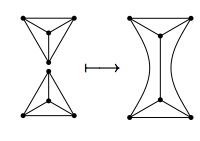If one takes a planar cubic non-Hamiltonian graphplanar cubic non-Hamiltonian graph, and takes the vertex connect sum of 3 copies, then it cannot have such a 2-factor. It's not hard to check that a vertex connect sum of such graphs is also non-Hamiltonian. If there were a 2-factor with only two components, it would have to traverse two of the 3 edges connecting one of the pairs of subgraphs. But then one of the two sides must be Hamiltonian, a contradiction.
Here's a picture of a vertex sum of planar cubic graphs:

